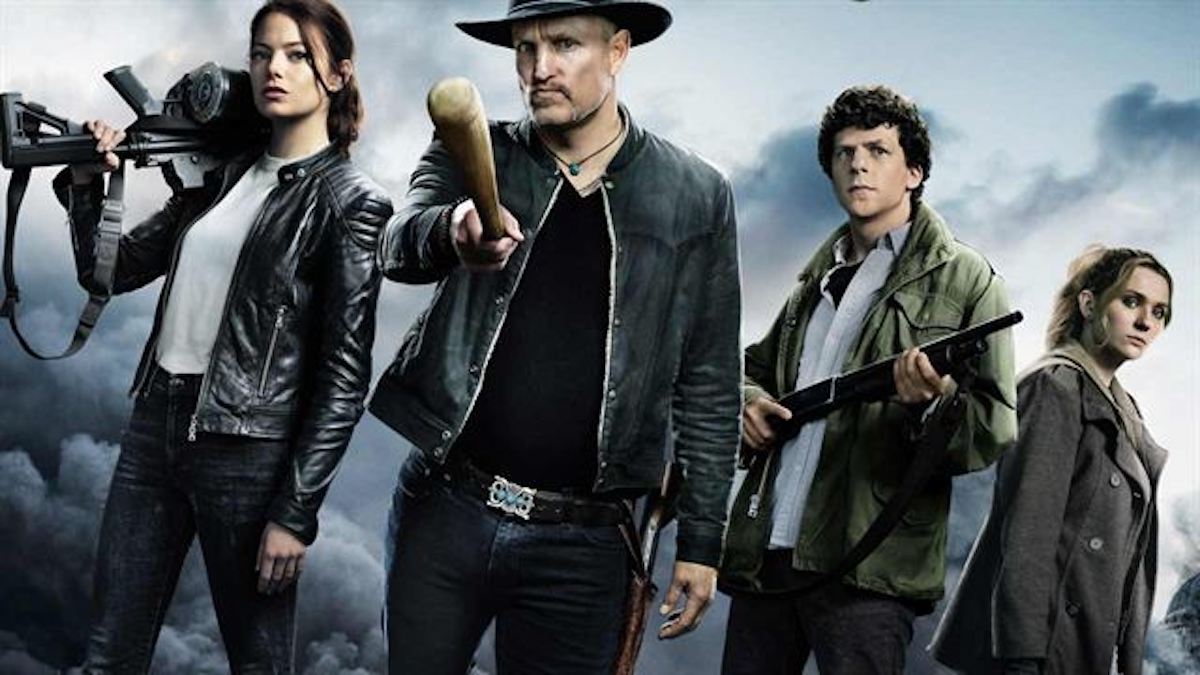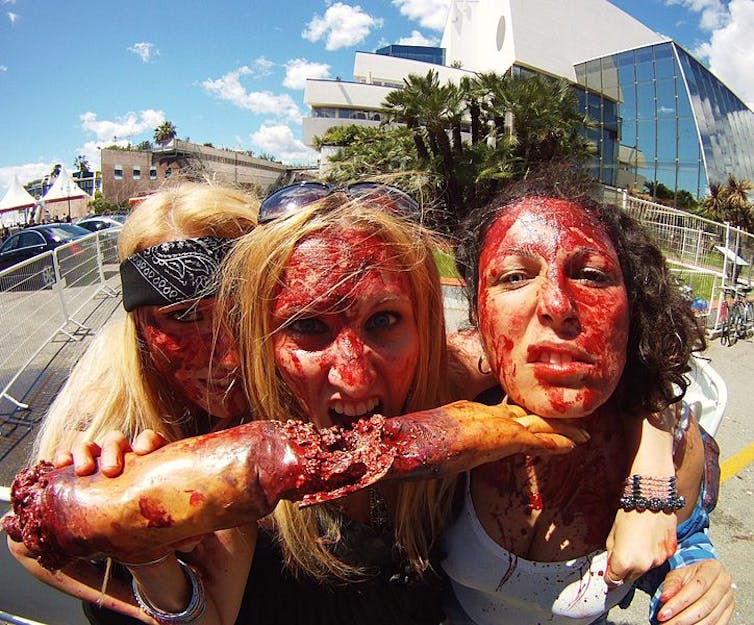Welcome to Coronaland! Are humans becoming zombies?
By constantly feedingthe imagination of the masses, the theme of the zombie apocalypse has raised awareness. The incessant stimuli produced by scenarios of contamination and images of the undead trigger fears that, more than the coronavirus itself, are spreading like wildfire across the globe.
Abdel Aouacheria, University of Montpellier

Allociné
To avoid giving in to the virus, including and especially in our own humanity, why not listen to what zombies have to say about ourselves?
Images from apocalyptic films
Far from the official rhetoric about the stages of the epidemic (1, 2, and soon 3), anxiety is palpable and tensions are erupting here and there.
Special broadcasts follow one after another, news channels deliver their statistics in real time (number of infected, deaths, recoveries). Imagesof deserted airports and cities under quarantine, with their living dead, seem straight out of the studios, reminiscent of World War Z (Marc Forster), Dawn of the Dead (George Romero) and 28 Days Later (Danny Boyle).
The fight against Covid-19 already has its martyr: Li Wenliang, a doctor who became a hero for being the first to warn of the dangers of the virus, before dying from it himself.
Surgical masks and hand sanitizer are flying off the shelves in pharmacies, while essential items are disappearing from supermarkets. Events are being canceled and schools are closing everywhere. Financial markets are plummeting.
With the outbreak of coronavirus, the world seems to have turned into a life-size film set for a new zombie movie: welcome to Coronaland (inspired by Ruben Fleischer's Welcome to Zombieland ).
The viral threat breaks social ties
With viral threats and zombies, both habits and living spaces become rooted in conflicting realities. While the coronavirus, like the zombie horde, appears to be a homogeneous threat, it always reveals heterogeneity and division among humans. This is because the virus, like the zombie, can infect anyone—loved ones, neighbors, colleagues—turning others into potential dangers.
Even Pope Francis has been asked to show his credentials, with the Vatican not being spared. The threat is no longer just the invisible virus itself, but also the sick person, who is clearly visible and with whom cohabitation becomes problematic.
Social ties are breaking down in a centripetal movement from the virus to the clan. The virus, a barbarian from the sub-world —the world of shady beings who do not fully or permanently meet the criteria of life—exacerbates paranoia and the rejection of foreigners. This has led to recent incidents of anti-Chinese racism and even attacks on European tourists in Martinique. Panic also leads to the stigmatization of migrants.
New preventive measures are being put in place to govern social interaction, such as prohibiting physical contact ("greet without shaking hands, avoid hugging," according to the government website ), which effectively encourages people to live separately.
As in the case of a zombie apocalypse, dynamics of disconnection begin to take precedence: the spared vs. the infected, priority patients vs. other patients, sedentary people vs. migrants, controllers vs. the controlled, white coats vs. ordinary citizens...
The advent of biopolitics
As illustrated in the film Land of the Dead (2005) and the television series The Walking Dead, zombie-infested areas tend to be overpopulated urban areas and places of confinement. We thus find bunkerized shelters, where a small group of healthy humans, caught up in survivalist logic, take refuge.
Writer Max Brooks has compiled these places and practices in a playful way in his The Zombie Survival Guide. This logic of confinement is not new: it echoes the political threats of the Cold War and the imminence of the bomb (think of George Pal's Time Machine or Kurosawa's Living in Fear ).
Next, quarantine sites are set up to control populations through medical and disciplinary measures: temperature checks, analysis of movements. Freedoms may be suspended in the name of reasons of state, which have become the guarantor of public health.
This is the biopolitical era: what matters most is the implementation of a dual disciplinary logic, in the words of Michel Foucault, namely, stopping evil and improving the exercise of power. The requisitioning of mask stocks is a symbol of this.
Cellular processes and crisis management
These reactions fall halfway between collectiveapoptosis —when the cell isolates itself and self-destructs in a controlled and methodical manner through a genetic program—and the cellular danger response.
The purpose of this latter process, introduced by American pathologist Robert K. Naviaux, is to help protect the cell from stress or danger and initiate the healing process. When this process is blocked, cells behave as if the threat were still present, preventing the healing cycle from being completed.
However, responses to crises raise the question of a return to normalcy, i.e., resilience. Can our societies truly recover from these situations, which are perceived as exceptional and temporary? It should be noted that the neo-zombie (putrefied, cannibalistic, catatonic, etc.) emerged and became prevalent in the aftermath of September 11, from which we have still not recovered.
There is therefore reason to fear that the current episode, following on from SARS and avian flu, will continue to lower the collective tolerance threshold for security and segregation measures.
The reflection of our anxieties
Zombies reflect our fears, particularly those related to death, while also representing a possible image of our own demise.
The coronavirus, like the zombie threat, fuels conspiracy theories and rumors, whichthe World Health Organization (WHO) has decided to combat.
The former generally depict experiments that have gone wrong (as in the Resident Evil franchise) or serve hidden interests (to the point of accusations of a forced passage of 49-3). Mystical explanations are put forward, with the infection being likened to expiatory punishment or a "Gaia reaction" to limit the human population.
The latter produce miracle cures: chloroquine,children's urine, cocaine, and garlic (already popular against vampires). Misinformation also blames scapegoats such as pangolins or the ever-present bat, which may be subject to reprisals.
Viral spread at the heart of "Coronaland"
Commercial offers from hospital vendors are also spreading at lightning speed, with the sale of mask kits. This virality is what makes Coronaland what it is. Anything and everything can spread quickly and unpredictably there.
From the precautionary principle to misinformation, anything goes when it comes to alleviating unbearable uncertainty. The search for patient zero, as depicted in the film Contagion (minus the zombies), is also part of this approach, to the point of causing concern at the Davos Forum.
Although the authorities are stepping up their efforts to track down the virus, these efforts are proving fruitless, especially since there are asymptomatic carriers of the coronavirus.
Furthermore, what is the point of trying to contain the initial spread of contamination in an era of globalized ecosystems? This can be interpreted as a desire to control a viral threat that is perceived as irrational, mindless, shifting, and mutating. This is what led the Pentagon to publish a scenario to be implemented in the event of a zombie invasion ( CONPLAN 8888-11), a kind of hyperbole of the viral pandemic.
The zombie embodies change
If the infection was able to activate the zombie fantasy so quickly, it may be because the zombie actually lives within us today.
What if, with the current crisis, the threat were not primarily that of zombification, of the de-civilization of human beings? "The zombie embodies change," director George Romero told Positif magazine in 2008.
For the father of modern zombies, what matters is how people react to the disaster, not the threat itself.

Olivier06400/Wikimedia, CC BY
What the zombie metaphor tells us is that it is our responsibility to mitigate the yoke of our primitive fears, to place ourselves outside the dictates of the survival instinct, primary fantasies, and consumerism to which we are prey (as much as we are to viruses).
Ultimately, the "complex" objects that are zombies place us in the hands of Edgar Morin's beloved Gospel of perdition. They are complex objects because zombies appear not only as a social phenomenon (notably with the recent trend of "zombie walks") and transmedia products (cinema, literature, comics, video games, and music), but also in medicine, with pathologies whose symptoms evoke the putrefaction of zombies (such as Buruli ulcer), in the natural sciences (with the manipulation of their hosts by certain parasites), and in philosophy (with the concept of the philosophical zombie).
Sharing the Earth with countless microbes has always been humanity's lot, and will continue to be so for a long time to come. The living world also cultivates a blind indifference to the fate of its components. If humanity were to disappear (or at least change its behavior), the rest of the biosphere would likely be better off, as suggested by the dramatic decline in pollution levels in China.
Faced with infectious diseases that bring us back to our animal nature, we must respond not only with greater hygiene measures and more research, but also with greater humanity, that is to say, fraternity, solidarity, creativity, and collective intelligence.
This article was co-written by Joachim Daniel Dupuis, Doctor of Philosophy, film professor, and author of the book Romero et les zombies, autopsie d’un mort-vivant (Romero and the Zombies: Autopsy of an Undead) (L’Harmattan, 2014).![]()
Abdel Aouacheria, Biologist, Research Fellow at the CNRS, specialist in cell life and death. University of Montpellier
This article is republished from The Conversation under a Creative Commons license. Readthe original article.